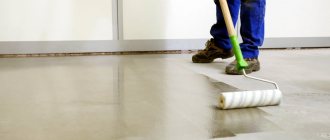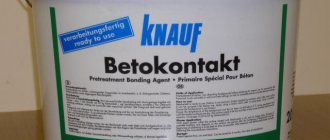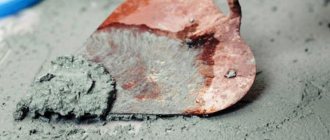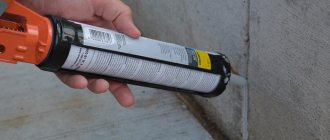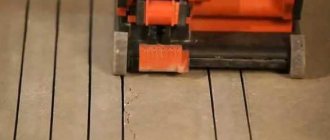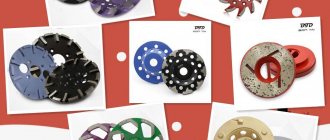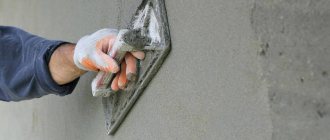Despite its strength, concrete is susceptible to the influence of humidity and temperature, mold, mildew and other microorganisms form on it. All this leads to the destruction of structures, which over time begin to look unsightly. Special concrete paint for exterior use (wear-resistant, moisture-resistant and durable) will allow you to preserve the facade of the building, the fence and the flooring inside the house for a long time not only from mechanical damage, but also from other negative “phenomena”.
To determine what to paint concrete on the street with, first of all we will consider the properties that such compositions should have.
Requirements for paints
Wear-resistant concrete paints for exterior use must also have:
- Water-resistant (after painting the facades, moisture should not penetrate into the room, so the water absorption of the composition should be 0%).
- Fire resistance (the composition must be non-flammable).
- UV resistant. If you purchase light-resistant paint for concrete walls, the surface will never fade. First of all, this applies to decorative compositions, which should not fade, even on walls located on the south side of the house.
- High level of adhesion. Thanks to this, the facade paint will better “adhere” to the base and stick to it. If the composition has low adhesion, then the painted walls will quickly begin to peel off.
- Resistant to temperature changes. If the walls are covered with a composition that is not resistant to frost and heat, the coating will quickly lose its appearance. Therefore, it is better to choose a coloring material that can withstand from -40 to +40 degrees.
- Vapor permeability (so that condensation does not form on the walls).
- Resistant to mechanical damage.
Healthy! Of course, all these properties will not have the desired effect if you neglected to prepare the concrete walls for painting (did not clean the surface, did not repair cracks, etc.).
Now, let's look at the main types of concrete paints for outdoor use.
Painting inside and outside, what's the difference?
There is a difference when painting concrete walls inside and outside. These are completely different conditions. On the street, the wall is exposed to negative influences. As for coloring, there are two differences:
- Temperature conditions. Concrete indoors is in “greenhouse” conditions and is not exposed to sudden changes and frost. The same cannot be said about external surfaces. Therefore, work there must be carried out at temperatures above 5 ℃. Also, the process is performed in cloudy weather, when direct sunlight does not hit the concrete.
- Lead time. Painting concrete inside can be done at any time. And external work must be carried out depending on the weather and time of day, so that morning and evening dew does not form.
If these conditions are met, the paint applied to the concrete outside will not crack and will last much longer.
Types of paints for exterior use
Today the market offers the widest selection of different coloring compositions:
Limestone
Paints of this type create a fairly durable protective layer on the surface. Lime compositions practically do not get dirty and have a very “minor” consumption (150 g/m2). Before applying such paint, it is necessary to level the surface, clean it, apply a primer and wet the base.
Walls should not be treated with lime compounds on a hot or sunny day. The service life of the paintwork is no more than 3 years.
Water-based
Water-based paints for concrete for exterior use are easy to apply, low consumption, low cost and have a good choice of colors. However, these environmentally friendly compounds have many disadvantages:
- wear out quickly;
- unstable to moisture, mechanical stress, chemicals and temperature changes;
- do not have protective properties.
Therefore, such coloring compositions are rarely used for treating concrete fences and building facades.
Water-epoxy
When deciding how to quickly paint concrete, many are afraid to use water-based paints and varnishes. However, it is worth considering that such facade paints contain synthetic resin and special additives that form a good protective coating.
Such paints for concrete for exterior use are two-component, so before applying them it is necessary to mix the solution from jar “A” with the contents of package “B”. After 15 minutes, the first primer layer is applied, which dries for 18 hours. After this, you can repaint the walls.
This type of paint can be used to paint your home's foundation, basement, interior, fences, and more. Water-epoxy compounds are environmentally friendly, but they can only be applied at above-zero temperatures. The consumption of paint material is 250g/m2.
Oily
Oil-based paint is also notable for its low price, but compared to water-based paint, it withstands ultraviolet radiation, does not allow moisture to pass through, and has protective properties.
Among the disadvantages of such compositions, it is worth highlighting the long drying process of surfaces and low vapor permeability. In addition, before painting a concrete wall, it will have to be carefully prepared (leveled and primed).
Acrylic
Acrylic paint for concrete, made on the basis of polyacrylates and copolymers, is resistant to abrasion, moisture, fungi and bacteria. Walls treated with this composition can be easily washed with ordinary detergents. In addition, elastic acrylic paint for concrete dries quickly and provides good vapor permeability. The main advantage of acrylic is that it retains its color throughout its entire service life (10 years).
Environmentally friendly acrylic paint is suitable for concrete floors, fences, walls, facades and for treating surfaces inside the house. You can also safely paint expanded clay concrete with this composition.
The only drawback of this paint is its high cost and rather high consumption (400 g/m2).
Acrylic silicone
Paints of this type are applied in two layers (with a break of 3 hours). The surface dries quickly, and the material consumption is 100 – 300 g/m2. In addition, the composition has all the advantages and properties of acrylic paints, but is much cheaper.
Important! Paints of this type must be diluted with water (up to 20-30%).
Latex
Wear-resistant latex-based paints are another type of acrylic compositions, since their main components are also PVA glue and copolymers. Such paints and varnishes cost almost half as much as acrylic ones, but have similar properties. The low price is due to the shorter service life and the “propensity” of the composition to burn out.
Polymer and vinyl
All polymer paints for concrete are not “afraid” of the cold, so they can be used to treat surfaces at any time of the year. Also, compositions of this type form a durable coating on the base that can withstand mechanical loads and is not affected by chemicals. This concrete paint for exterior use can be applied using any method: using a roller, sprayer or regular brush.
Healthy! Before painting a concrete fence or wall with polymer paint, be sure to treat the base with a primer consisting of paint and water.
Polymer and vinyl materials are characterized by uniform coloring - the color is uniform and bright. They can be used for both external and internal work.
However, when deciding how to paint a concrete floor or any other surface, keep in mind that the service life of vinyl paint is 5-7 years, and polymer paint – up to 20 years.
Also today there is a new type of paint on the market - rubber. We will look at it in more detail.
Scope of application
Due to the high technical and operational properties, the unlimited scope of application of acrylic paints is not surprising. They can be used on almost all types of bases, be it wood, concrete, stone or metal, with the exception of some types of plasterboards, which greatly simplifies the choice of materials when carrying out finishing or repair work. In the line of any manufacturer there is always paint for interior and exterior work in a wide range of colors, therefore, there will be the same quality of the painted surface and matching shades during transitions.
When choosing, it is worth considering that there are universal paints in terms of bases, but within the group they usually differ in the specific application - for walls, ceilings and floors. This is due to a practical component - these zones have different operating conditions, and they look different due to the different angle of incidence of light. And the application technique is different, which determines the consistency and composition of the additives.
The popularity of acrylic paints is also explained by the atypical color range - while standard floor enamels are overwhelmingly brown, acrylic ones can be of any color.
Vlademir FORUMHOUSE Member
My wife wants floors at home that are not the color of traditional floor paint, but light, with a brownish tint, that is, as light as possible. Nearby stores offer acrylic flooring; the manufacturer's assortment includes a light color. Does anyone have experience?
Eat.
Nika19 Member of FORUMHOUSE
We painted with water-soluble acrylic, the color was a straw. It turned out to be light-light yellow, a nice shade, I also love light floors.
Features of rubber paint
Relatively recently, a new product appeared on sale - rubber-based paint. It contains many components (additives of silicone, acrylic and other components), thanks to which the composition is easy to apply and forms a moisture-resistant coating on the surface that does not fade or become damaged for a long time.
In addition, rubber paints have the following advantages:
- noise absorption;
- environmental friendliness;
- the ability to choose from a wide range of colors;
- resistance to chemicals, fungi and mold;
- high elasticity;
- good vapor permeability;
- waterproofing properties.
In addition, rubber concrete paint can be easily removed if at some point you decide to update the finish. To do this, it is enough to use “gentle” washes.
Healthy! After the paint dries, it becomes matte.
Most often, rubber paint is used for concrete floors in apartments, garages, gyms, balconies and so on. Since the composition does not lose its properties at temperatures from -55 to +60 degrees, it is often used to treat street paths, blind areas and fences. If you are deciding what to paint your foundation with, modern rubber paint is a good choice.
Healthy! The paint cannot be applied in a thick layer, so it is used to cover surfaces in 2-3 stages.
It's also worth considering a few tips on how to paint a concrete floor if you're doing the work yourself.
Manufacturers
It is important to purchase façade paint for painting concrete surfaces from the following manufacturers:
- Great Britain.
- Türkiye.
- Tikkurila. Finland/Russia.
- Profilux. Russia.
- ELCOM. Russia.
After reading the article, the choice of facade paint will be significantly easier.
Our expert advises reading this:
- Properties, types and use of facade paints for bricks for exterior work Brick facades withstand the aggressive influence of external factors well. But rains, frosts, winds and bright sunlight can have their destructive effect...
- Facade paint for plaster: types and features for exterior work The plaster facade is modern and beautiful. To create a universal exterior, you can use paints. Thanks to the presence of a large number of shades, it is possible…
- Choosing wear-resistant concrete paints for floor work Painting a concrete floor everywhere serves to prevent damage to the surface. Concrete flooring is by default associated with reliability and durability, but without…
How to paint concrete surfaces
In order to perform staining correctly, perform the following simple manipulations:
- Before painting concrete yourself, remove debris, dirt and dust from the surface to be painted.
Healthy! If you are applying the composition to the floor in a multi-story building, then make sure that the concrete screed located on the ceiling is not damaged. If there are chips in it, repair them.
- Apply primer to the base (if necessary).
- Mark the boundaries of the area to be painted with masking tape.
- Mix the mixture thoroughly and pour a small amount of paint into the tray.
- Lower the brush 1/3 of the way into the tray.
- Apply the durable concrete floor paint evenly (brush on the edges and roller on the center).
Healthy! You can also use an airless spray gun (pressure 200 bar).
- Wait until the first coat of paint has dried (good air circulation must be ensured in the room) and apply the next coat, if the instructions for the composition indicate that a two-layer coating is required.
Also keep in mind that before painting a concrete floor or wall, you need to prepare a solvent for cleaning brushes and take care of personal protective equipment (gloves, a respirator and clothing that you don’t mind).
It is better to paint at a temperature 2-3 degrees above the dew point.
Making a choice
To choose the right paint composition, you need to evaluate how the concrete surface will be used - for example, walls require paint that is not as durable as if you need to paint a garage floor.
For indoor work, non-toxic options are chosen; for outdoor use, weather resistance is more important. Some choose universal options, but before you settle on this, you need to carefully study all the information about the paint and tips for use.

